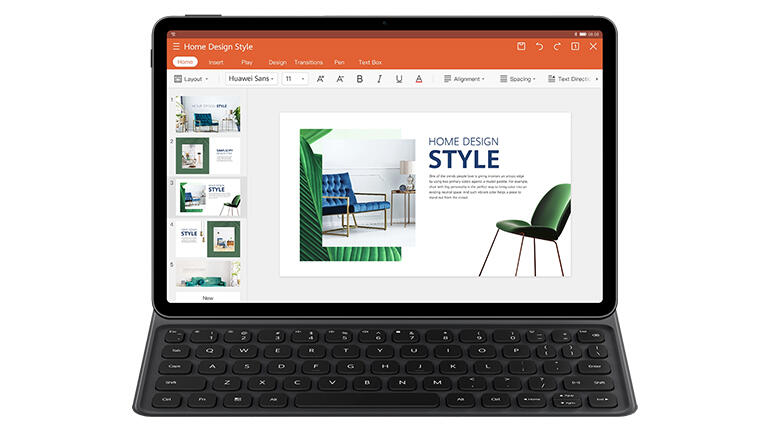It’s a setup that people may look to as their only computer. But if that’s the case, they are going to have to get used to HarmonyOS, an operating system and services suite that Huawei developed after being shut out of Google Mobile Services in a dispute with the US.
This matters because familiar ways of working may have to be set aside, and familiar applications given up for alternatives. For example, if you’ve bought into the Google ecosystem for productivity you’ll need to access its services via a web interface rather than via native apps. There will be a learning curve for many people.
Still, HarmonyOS has been designed to have a familiar look and feel, and it includes a lot of basics like a web browser, image gallery, map and route planning app, calendar, weather tool, plus support for Gmail, Exchange, Outlook email and other providers via manual setup.
One important place HarmonyOS trips up is app support. Because the Google Play Store is absent, Huawei has developed its own Huawei AppGallery. This boasts apps across many categories including business, education, shopping, sport and health, entertainment, and lifestyle. But the number of apps can’t match the Google Play Store, and some popular apps are absent.
If you can’t find what you want in the Huawei AppGallery, you can try Petal Search, which will look for installable files across the internet. For example, for my own downtime needs neither the BBC iPlayer nor Prime Video are in the AppGallery, but I found both using Petal Search. Unfortunately installs via this route do not support automatic updating, so users will have to do manual checks.
All of that noted, HarmonyOS looks familiar, both in terms of the general screen layout and how settings are organised and made. There’s a control panel that can be swept down from the top right of the screen, and a notification panel accessed from the top left. Recent and pinned apps sit in a bar along the bottom of the main home screen. Some apps have associated ‘snippets’, which we might know better as widgets, that can be placed on a home screen. For example, the calendar app snippet will summarise today’s schedule.
Huawei has done a good job with the build of the MatePad 11, which is only available in Matte Grey in the UK – although elsewhere you can also get Isle Blue and Olive Green. It’s a familiar rectangular shape, measuring 253.8mm wide by 165.3mm deep by 7.25mm thick and weighing 485g. There are smallish bezels around the screen and Huawei claims a screen-to-body ratio of 86%, although our calculation puts it at 82.9%. Four speakers output good-quality sound via a pair of grilles on either side of the (landscape mode) screen. There is a caddy for a MicroSD card that can be used to boost the 128GB of internal storage, of which 17GB is used out of the box.
SEE: The 10 best Windows laptops: Top notebooks, 2-in-1s, and ultraportables
The Qualcomm Snapdragon 865 chipset seemed speedy enough while I was testing the MatePad 11, which had 6GB of RAM. There is a 13MP f/1.8 camera at the back and an 8MP f/2.0 front camera for video calling. There’s nothing particularly special about the photography options, although the rear camera can shoot 4K video.
The 10.95-inch IPS screen is stunning. It’s sharp and bright with a resolution of 2,560 by 1,600 pixels (275ppi) and a 120Hz refresh rate. Huawei has included a reading mode that pushes everything into greyscale, which is a big plus point for me. However, the screen is very reflective, which makes working a little tricky at times.
Huawei says the 7250mAh battery will last for 12 hours, and in everyday use I found it could handle a day’s typical workload of writing, browsing and streaming, plus a little after-hours music and video streaming. The downside is 22.5W charging, which is fairly slow.
Unfortunately, I was unable to test the MatePad 11 alongside its dedicated keyboard, because Huawei sent me a keyboard for a different device. That’s a shame, as it meant I could not use the full 2-in-1 setup to write this review or complete other writing-based workloads.
Focusing on the tablet itself, the MatePad 11 is well made, with good battery life and decent speakers. The all-inclusive price for tablet, keyboard and stylus – currently £399.99 in the UK – is not excessive. The big drawback may end up being HarmonyOS, which won’t suit everybody, particularly when it comes to app support.
Huawei MatePad 11 specifications
Alternatives to consider
Huawei’s MatePad 11 is up against some stiff competition, including similar-sized tablets from big names like Apple, Samsung and Nokia. RECENT AND RELATED CONTENT MWC 2022: Huawei launches high-end laptop, OLED 2-in-1, AIO PC and E Ink tablet Huawei unleashes HarmonyOS in China, eyes multi-device ecosystem Samsung Galaxy Tab S8 Plus review: The best Android tablet for most people The 7 best tablets: Ditch the laptop Read more reviews
Microsoft Surface Laptop Go 2 review: Stylish and lightweight, but battery life could be betterAsus Zenbook Pro 16X OLED (UX7602) review: A high-spec creator laptop with a superb screen and tilting keyboardSteelSeries Apex Pro Mini keyboard review: A small but mighty gaming toolSony INZONE H9 review: The XM5 of gaming headphonesApple Watch SE vs Apple Watch Series 7: Which should you buy?
